- Gameumentary
- Review in 3 Minutes
- Design Delve
- Extra Punctuation
- Zero Punctuation
- Area of Effect
- Escape the Law
- In the Frame
- New Narrative
- Out of Focus
- Slightly Something Else
- Terms of Service
- Privacy Policy

5 Faster-Than-Light Travel Methods and Their Plausibility
Science tells us that it is impossible for an object to travel at light speed, let alone faster than that. But so many of our favorite science-fiction movies, games, and TV shows rely on faster-than-light travel to craft their interplanetary adventures.
Let’s take a look at five means of FTL found in sci-fi that don’t break the rules of relativity and examine how plausible they are based on the science behind them.
1. Hyperdrive
Popularized by Star Wars and used extensively in fiction, a hyperdrive enables a spaceship to travel at FTL speeds by entering another dimension known as “hyperspace.” The spaceship isn’t actually traveling faster than the speed of light, but rather is making use of hyperspace as a shortcut, and the hyperdrive is the mechanism that shunts the spaceship into and out of this parallel dimension.

Specific coordinates within hyperspace have corresponding coordinates in normal space, but the distance between those two points will be shorter in hyperspace, allowing for a faster journey. Before making a “hyperspace jump,” calculations must be made to find the matching coordinates between hyperspace and normal space in order to know when and where to exit hyperspace at the desired normal space destination.
Is it plausible?
Physicist Bukrhard Heim proposed a theory in 1977 that FTL travel may be possible by using magnetic fields to enter higher-dimensional space. The theory uses a mathematical model that calls upon six or more dimensions in an attempt to resolve incompatibilities between quantum mechanics and general relativity, but Heim’s ideas have not been accepted in mainstream science. Still, the fact that a theoretical physicist devoted a large portion of his life in pursuit of a theory that could lead to a means of space travel lends the concept of hyperspace a little more credibility than if it were simply the fancy of a sci-fi writer.
2. Jump Drive

Seen in such works as Battlestar Galactica , a jump drive allows for instantaneous teleportation between two points. Similar to a hyperdrive, coordinates must be calculated to ensure a safe jump; the longer the desired travel distance, the more complex the calculation. In theory, there is no limit to how far a jump can take a ship, but an incorrect calculation may result in a catastrophic collision with a planet or space debris.
The Dune universe’s FTL, based on the fictional “Holtzman effect,” can also be considered a jump drive.
Master of hard sci-fi Isaac Asimov was the first to suggest the idea of a jump drive in the Foundation series, which lends some credibility to the idea. However, most fiction doesn’t clearly explain the principles of physics that allow for this teleportation, making it impossible to claim a jump drive as plausible. However, if it functions by opening a wormhole…
3. Wormholes

A wormhole, as seen in the Stargate franchise, allows for near-instantaneous travel across vast distances. Wormholes may be naturally-occurring or man-made, but are almost always temporary and serve as tunnels through spacetime.
Imagine our universe as a piece of paper, and an ant walking on that piece of paper as a spaceship. If the ant wants to walk from one end of that piece of paper to the other, the fastest way to do so would be to travel in a straight line. But paper, like space, bends. If you bend the paper into a U shape, the ant’s journey goes largely undisturbed – it still has to traverse the same distance along that line. However, in 3D space, the two ends of the paper are very close to each other now. Cut off a piece of a drinking straw and let the ant use it as a bridge or tunnel between the two ends of the paper, and the journey is suddenly much shorter.

While we have never directly observed any evidence for one, wormholes are theoretically possible. Albert Einstein and his colleague Nathan Rosen first discovered wormholes in 1935 as solutions to equations within Einstein’s general theory of relativity – the math says they can exist.
Since then, other scientists, including Stephen Hawking, have argued that it may be possible to traverse a wormhole, under the right circumstances. The debate surrounding wormholes isn’t about their plausibility, but rather how they may be created and sustained.
4. Slipstream

The concept of slipstream can be found in such works as Star Trek , Doctor Who , and the Halo video game franchise, but there is no widely-agreed upon definition of what slipstream is or how it works beyond it being a means of FTL. We’ll consider the slipstream seen in Gene Roddenberry’s Andromeda , where it is “not the best way to travel faster than light, it’s just the only way,” as per the show’s protagonist.
Slipstream is a form of interdimensional highway in which ships ride a series of slipstream “strings” – the unseen connections between all objects in the universe. These strings are in constant flux and form a tangled mess of intersections and divergent paths. Any time a pilot reaches a fork in the road, he has to guess which is the correct path to take to continue along toward his desired destination. Before the pilot makes that decision, both paths are simultaneously the correct and incorrect route, and it is the act of choosing a path that forces one to be correct and the other to be incorrect – if this made you think of Shrödinger’s cat, that does seem to be the basis for this concept. A computer selects the “correct” path 50% of the time, but due to intuition, a human picks the correct path 99.9% of the time.
There are no mainstream scientific theories that support this idea of slipstream. Reading the “lore” of this means of FTL evokes fantastical interpretations of string theory, quantum entanglement, and other concepts in modern physics, but the ideas are supported only through their internal consistency rather than actual fact, much like a well-explained magic system that allows fictional wizards to cast spells.
5. Warp Drive

Popularized by Star Trek , a warp drive distorts space around a ship while leaving the ship itself inside a “bubble” of normal space. The space in front of the ship is contracted, while the space behind it is expanded, and the ship “rides” the distortion wave at FTL speeds. Technically, it is not the ship that is moving, but rather space itself, which is how we avoid breaking any laws of physics.
Imagine a surfer slowly paddling back to shore. When a wave comes, it will lower the water level in front of him and raise the water level behind him, and he can ride the downward slope all the way to shore. Relative to the wave, the surfer isn’t moving – he’s staying between the crest and the trough, and it is instead the wave that is moving.
Surfing doesn’t quite work like that, but it’s a simplification that we can all visualize. In a similar manner to how a wave will distort water to propel a surfer, a warp drive will distort space to propel a ship.

In 1994, the Alcubierre drive was proposed as a theoretical means of FTL travel and is based on a mathematical solution to equations within Einstein’s general theory of relativity. Just like a warp drive, the Alcubierre drive would contract space in front of a spaceship and expand space behind it.
NASA has been actively researching this technology since 2012 , and the lead researcher even worked with a 3D artist to develop a model of what a warp-capable ship might look like . As far as real-life FTL goes, warp is the current front-runner to becoming reality.
As far as real-life FTL travel goes, the fictional favorites can be found in Star Trek and Stargate : the warp drive, and wormholes. Both are theoretically possible; however, both require further scientific breakthroughs before practical testing can begin. In either case, we need to discover “exotic matter” – hypothetical particles with negative mass – to get these mechanisms to work. “Element zero” from the Mass Effect series, the rare material that is essential to FTL travel in that universe, doesn’t quite fit the description, but the lore is at least scientifically sound in suggesting that some new, rare form of matter is required to make this technological leap.
The good news is that scientists don’t believe this is a matter of if, but rather when. There will be a time in the future when a stately, bald man in uniform will sit back in a command chair and relay the order, “Engage.”
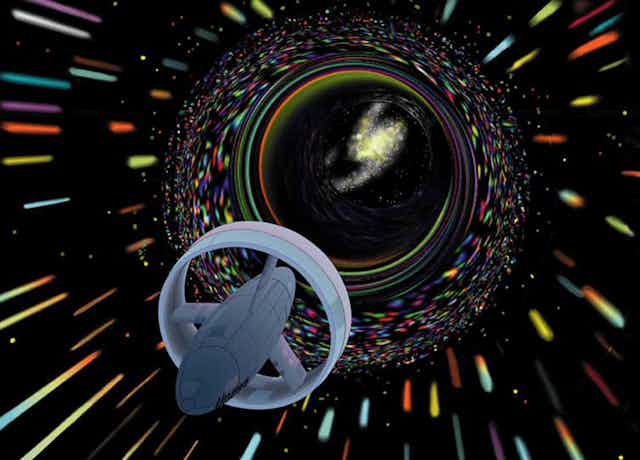
Warp drives: Physicists give chances of faster-than -light space travel a boost
Associate Professor of Physics, Oklahoma State University
Disclosure statement
Mario Borunda does not work for, consult, own shares in or receive funding from any company or organisation that would benefit from this article, and has disclosed no relevant affiliations beyond their academic appointment.
Oklahoma State University provides funding as a member of The Conversation US.
View all partners
The closest star to Earth is Proxima Centauri. It is about 4.25 light-years away, or about 25 trillion miles (40 trillion km). The fastest ever spacecraft, the now- in-space Parker Solar Probe will reach a top speed of 450,000 mph. It would take just 20 seconds to go from Los Angeles to New York City at that speed, but it would take the solar probe about 6,633 years to reach Earth’s nearest neighboring solar system.
If humanity ever wants to travel easily between stars, people will need to go faster than light. But so far, faster-than-light travel is possible only in science fiction.
In Issac Asimov’s Foundation series , humanity can travel from planet to planet, star to star or across the universe using jump drives. As a kid, I read as many of those stories as I could get my hands on. I am now a theoretical physicist and study nanotechnology, but I am still fascinated by the ways humanity could one day travel in space.
Some characters – like the astronauts in the movies “Interstellar” and “Thor” – use wormholes to travel between solar systems in seconds. Another approach – familiar to “Star Trek” fans – is warp drive technology. Warp drives are theoretically possible if still far-fetched technology. Two recent papers made headlines in March when researchers claimed to have overcome one of the many challenges that stand between the theory of warp drives and reality.
But how do these theoretical warp drives really work? And will humans be making the jump to warp speed anytime soon?
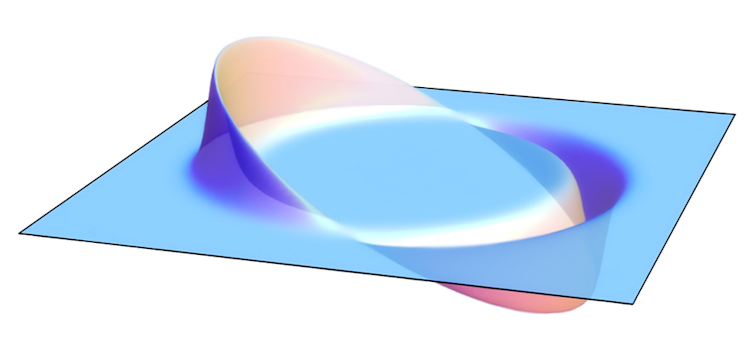
Compression and expansion
Physicists’ current understanding of spacetime comes from Albert Einstein’s theory of General Relativity . General Relativity states that space and time are fused and that nothing can travel faster than the speed of light. General relativity also describes how mass and energy warp spacetime – hefty objects like stars and black holes curve spacetime around them. This curvature is what you feel as gravity and why many spacefaring heroes worry about “getting stuck in” or “falling into” a gravity well. Early science fiction writers John Campbell and Asimov saw this warping as a way to skirt the speed limit.
What if a starship could compress space in front of it while expanding spacetime behind it? “Star Trek” took this idea and named it the warp drive.
In 1994, Miguel Alcubierre, a Mexican theoretical physicist, showed that compressing spacetime in front of the spaceship while expanding it behind was mathematically possible within the laws of General Relativity . So, what does that mean? Imagine the distance between two points is 10 meters (33 feet). If you are standing at point A and can travel one meter per second, it would take 10 seconds to get to point B. However, let’s say you could somehow compress the space between you and point B so that the interval is now just one meter. Then, moving through spacetime at your maximum speed of one meter per second, you would be able to reach point B in about one second. In theory, this approach does not contradict the laws of relativity since you are not moving faster than light in the space around you. Alcubierre showed that the warp drive from “Star Trek” was in fact theoretically possible.
Proxima Centauri here we come, right? Unfortunately, Alcubierre’s method of compressing spacetime had one problem: it requires negative energy or negative mass.
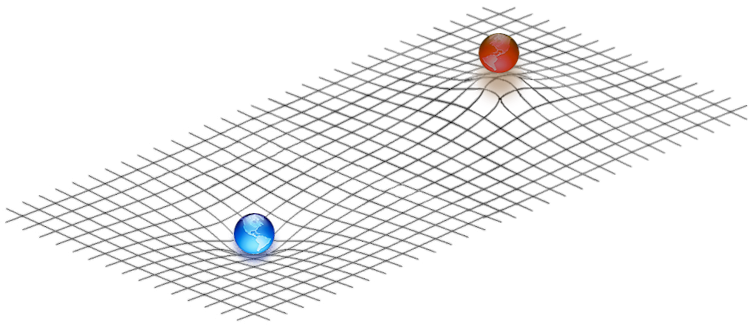
A negative energy problem
Alcubierre’s warp drive would work by creating a bubble of flat spacetime around the spaceship and curving spacetime around that bubble to reduce distances. The warp drive would require either negative mass – a theorized type of matter – or a ring of negative energy density to work. Physicists have never observed negative mass, so that leaves negative energy as the only option.
To create negative energy, a warp drive would use a huge amount of mass to create an imbalance between particles and antiparticles. For example, if an electron and an antielectron appear near the warp drive, one of the particles would get trapped by the mass and this results in an imbalance. This imbalance results in negative energy density. Alcubierre’s warp drive would use this negative energy to create the spacetime bubble.
But for a warp drive to generate enough negative energy, you would need a lot of matter. Alcubierre estimated that a warp drive with a 100-meter bubble would require the mass of the entire visible universe .
In 1999, physicist Chris Van Den Broeck showed that expanding the volume inside the bubble but keeping the surface area constant would reduce the energy requirements significantly , to just about the mass of the sun. A significant improvement, but still far beyond all practical possibilities.
A sci-fi future?
Two recent papers – one by Alexey Bobrick and Gianni Martire and another by Erik Lentz – provide solutions that seem to bring warp drives closer to reality.
Bobrick and Martire realized that by modifying spacetime within the bubble in a certain way, they could remove the need to use negative energy. This solution, though, does not produce a warp drive that can go faster than light.
[ Over 100,000 readers rely on The Conversation’s newsletter to understand the world. Sign up today .]
Independently, Lentz also proposed a solution that does not require negative energy. He used a different geometric approach to solve the equations of General Relativity, and by doing so, he found that a warp drive wouldn’t need to use negative energy. Lentz’s solution would allow the bubble to travel faster than the speed of light.
It is essential to point out that these exciting developments are mathematical models. As a physicist, I won’t fully trust models until we have experimental proof. Yet, the science of warp drives is coming into view. As a science fiction fan, I welcome all this innovative thinking. In the words of Captain Picard , things are only impossible until they are not.
- General Relativity
- Theoretical physics
- Interstellar
- Speed of light
- Albert Einstein

Program Manager, Teaching & Learning Initiatives

Lecturer/Senior Lecturer, Earth System Science (School of Science)

Sydney Horizon Educators (Identified)

Deputy Social Media Producer

Associate Professor, Occupational Therapy
The idea that characters can fly from planet to planet, or star to star, defying current science and technology, is central to science fiction. Although some of these ideas predated the space age, after the 1950s, fictional depictions of space travel needed to suggest conceivable ways to cross interstellar distances to seem plausible. Some authors suggested faster-than-light drives, hyper drives, jump drives, worm holes, and black holes.
Scientific understanding of light speed as an absolute natural limit derives from Albert Einstein’s publications on special relativity in 1905, confirmed by his work on general relativity in 1916. In classical physics, speed has no limits. But relativistic theory shows that mass increases with acceleration until mass becomes infinite at light speed. Yet author E. E. “Doc” Smith imagined spaceships traveling faster than the speed of light in his “Skylark of Space” stories. Smith’s cover story appeared in the same issue of Amazing Stories in 1928 that included Philip Francis Nowlan’s first short story about Anthony (later “Buck”) Rogers.
Within a couple of decades, the fictional idea of faster-than-light travel made intuitive sense to a public familiar with recent supersonic flights. In 1947, Chuck Yeager broke the speed of sound aboard the Bell X-1 Glamorous Glennis . Writers extrapolated supersonic speeds into the idea of spacecraft traveling at multiples of the speed of light. Frank Hampson’s British comic Dan Dare offered one of the earliest uses of faster-than-light travel. In 1955, he introduced interstellar travel in “The Man from Nowhere” trilogy. The technology was inherently alien, however, and faster-than-light travel was not featured regularly afterward. Forbidden Planet (1956) was the first film to depict a fictional faster-than-light spaceship created by humans. From the exterior, the C-57D ship was an undifferentiated flying saucer. After a loudspeaker announcement, however, the crew stood in “DC stations” that held them immobile while the ship slowed. By the mid-1960s, however, as both the United States and the Soviet Union made regular human spaceflights, science fiction audiences became more intuitively aware of the time that it took to travel in space.
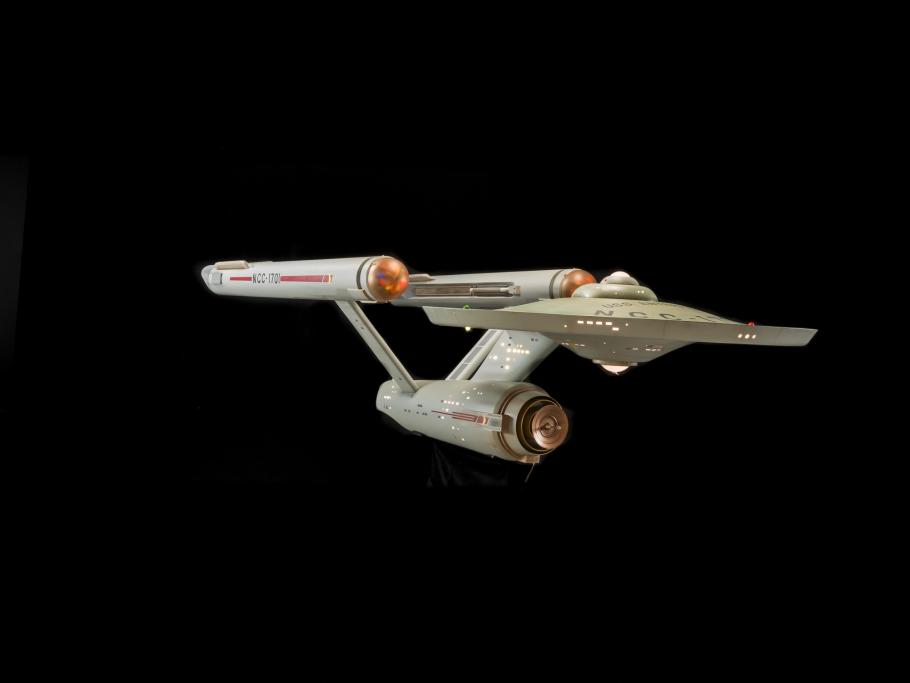
The U.S.S. Enterprise created for Star Trek (NBC, 1966-69) represented a major leap forward. Walters “Matt” Jefferies, a WWII flight engineer and private pilot, used “aircraft logic” to design a vehicle with components that visually communicated their purpose. With the two engine nacelles, Jefferies effectively invented warp drives, fictional engines that could propel the ship at multiples of the speed of light. As seen in Star Trek: First Contact (1996), the first flight of Zephram Cochran’s warp-capable Phoenix demonstrated the mark of a culture that was ready to participate in interstellar civilization. Jefferies’ design raised the bar for imagined vehicles. After Star Trek, undifferentiated flying saucers and flame-spewing pointed rockets largely disappeared from fictional depictions. Instead, imagined propulsion that bent space-time or traversed alternate dimensions become more prevalent.
Rather than just having the vehicles fly faster, some science fiction suggested traveling through or outside of normal four-dimensional space (including time), either by jumping within ordinary space, utilizing hyperspace, or exploiting natural or artificial shortcuts through space. Beginning in the 1940s, Isaac Asimov included jump drives in the short stories that later became his Foundation (1951) series of novels. Because fictional jump drives turn long flights into direct hops, allowing ships to disappear from one place and reappear in another, they facilitate storytelling without interrupting it. The reimagined Battlestar Galactica (2003) uses the same kind of travel but calls the mechanisms “FTL drives.”

A production model of the Millennium Falcon was on display at the Museum in 1998-99 as a part of the "Star Wars: The Magic of Myth".
The Star Wars universe postulates a hyperdrive, a computer-guided system that allows spacecraft to enter hyperspace at faster-than-light speeds and navigate to a successful exit at a distant destination. Solo: A Star Wars Story (2018) reveals that the extensive navigational maps and rapid calculating ability of the Millennium Falcon ’s hyperdrive computer are actually the downloaded memories of L3-37, a spirited and female-identified droid pilot.
The two-season program Buck Rogers in the 25th Century (NBC, 1979-1981) showed interstellar travel being accomplished using stargates. Four lights arranged in a diamond in space showed that the stargate had opened, offering access to hyperspace. A similar concept had a more physical presence in J. Michael Straczynski’s Babylon 5 (Syndicated & TNT, 1993-1998). In that show, external “jumpgates” shown using computer-generated imaging provided a physical infrastructure for generating stable vortices to hyperspace.
The idea of artificial space-time vortices as conduits drew power from speculation published in technical and popular literature. Speculation about wormholes must be distinguished, however, from black holes, which are real astronomical phenomena. Stories involving black holes often include time dilation. Einstein’s theories—including special and general relativity—explain that a person travelling near a massive gravitational field experiences time more slowly. The plot of director Christopher Nolan’s Interstellar (2014) employed time differences for dramatic purposes and also represented a giant leap in visual effects. To create the effect of the rapidly spinning black hole, theoretical astrophysicist Kip Thorne assisted the Interstellar production team. The resulting black hole appeared as a three-dimensional, spherical, hole in spacetime, drawing in all of the light around it. When the Event Horizon Telescope project imaged a real black hole in 2019, that image demonstrated how close to reality Interstellar ’s fictional imagination had come.
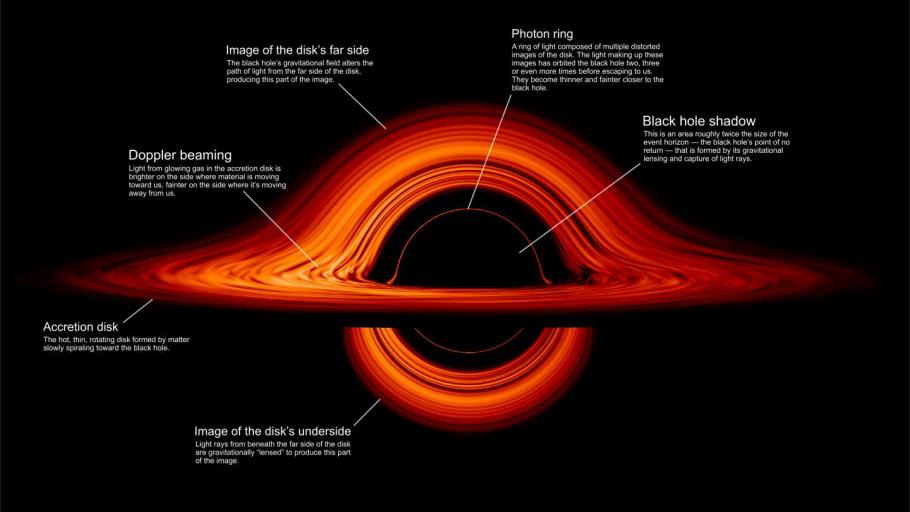
This explanation of the various aspects of a black hole shows the recent three-dimensional visualization.
Although writers have been imagining travel to space-based destinations for hundreds of years, the use of faster-than-light travel as a narrative device remains relatively young. As the sound barrier disappeared and the space age dawned, writers began imagining ways for interstellar travelers to cross the immensity of space. More important, audiences came to expect plausible explanations of faster-than-light travel to consider the stories credible.
Dr. Margaret A. Weitekamp is the Chair of the Museum’s Space History Department and author of “Ahead, Warp Factor Three, Mr. Sulu”: Imagining Interstellar Faster-Than-Light Travel in Space Science Fiction.” The Journal of Popular Culture 52 (2019), 1036-57.
We rely on the generous support of donors, sponsors, members, and other benefactors to share the history and impact of aviation and spaceflight, educate the public, and inspire future generations. With your help, we can continue to preserve and safeguard the world’s most comprehensive collection of artifacts representing the great achievements of flight and space exploration.
- Get Involved
- Host an Event
Thank you. You have successfully signed up for our newsletter.
Error message, sorry, there was a problem. please ensure your details are valid and try again..
- Free Timed-Entry Passes Required
- Terms of Use
Screen Rant
Ftl: the 10 best versions of space travel in sci-fi movies & shows, ranked.
Science-fiction films and television series often mess around with the concept of FTL space travel, and these ten franchises clearly did it best.
As avid viewers of science-fiction films and television series, the fictional practice of space travel fascinates us. Seeing how different sci-fi universes handle faster-than-light travel is endlessly entertaining.
RELATED: The 10 Most Bizarre Weapons In Sci-Fi Movies, Ranked
What is so great about this particular aspect of sci-fi is how different franchises will handle it. They'll call FTL travel by different names, use varying pieces of technology to utilize it, and be totally unique in how they make it appear. For today, we're going to go over the best sci-fi methods of FTL travel. Read on if you want to find out which movies and series handled it the best.
Gravity Drive/Artificial Black Hole - Event Horizon
Younger viewers might not recall the film Event Horizon . It was a thrilling sci-fi romp that involved demonic horrors leaking onto a ship thanks to some FTL travel gone wrong. The ship is using an experimental gravity drive meant to reduce the time it takes to travel through space by creating an artificial black hole for portal purposes. Unfortunately for the crew of the ship, this little hole in space-time leads directly to hell. And we mean that quite literally. This mode of FTL travel gets bonus points for being directly involved in the film's plot complications.
Boom Tube/Mother Box - Justice League
Call it what you will, this device is just one of those insane FTL inventions made to masquerade as teleportation. A Boom Tube is used to create openings across space and time that people, vehicles, and armies can use to traverse great distances.
RELATED: 10 Best Sci-Fi Movies About Artificial Intelligence, Ranked
And by great distances, we mean the space between universes. DC Comics struck gold with this idea because how else were the denizens of Apokolips and New Genesis supposed to terrorize Earth? Boom Tube technology featured heavily in the DC film Justice League , and if the film gets a sequel, you can bet it will involve more Mother Boxes.
FTL Jumps - Battlestar Galactica
Though Battlestar Galactica didn't have a snazzy name for their faster-than-light travel (they just called them "FTL jumps," really), this mode of transportation boosted itself up on this list thanks to the random chance it uses. For those of you who haven't seen the hit sci-fi show, just know that luck has more to do with "jumps" than coordinates. And for those of you who have seen the show, we will never listen to the song "All Along the Watchtower" in the same way ever again.
Shock - Dead Space
Granted, Dead Space started as a video game, but it has an animated film, too, so we thought we'd include it here anyways. Plus, its FTL travel is delightfully named. In Dead Space , space ships travel using ShockPoint drives. This means that when a ship is about to travel faster than the speed of light, crew members will frequently say, "We're about to shock out."
RELATED: 10 Best Sci-Fi Movies With Peaceful Aliens
That's a colloquial way of stating that the ship is about to enter ShockSpace, which functions as a sort of space that isn't space. It's like a bubble in space and time. For the simple pleasure of saying "shock out," we had to include Dead Space's method of FTL travel on this list.
Jumps - Guardians Of The Galaxy
The Marvel Cinematic Universe has its own method of FTL travel, but we wouldn't have included it if it hadn't been for the insane scene in Guardians of the Galaxy Vol. 2 . Yondu, Rocket, Kraglin, and Groot make 700 "jumps" through space-time in order to reach the rest of the team on Ego's planet in time. That many jumps takes a hilarious toll on their bodies, distorting them in funny, bubbly ways. It might be a spot of juvenile humor, but hey, if FTL travel can make you laugh, we count that as a win.
Slipspace - Halo
Like with Dead Space , Halo is primarily a video game, but since it has some live-action features and specials within its franchise, we thought we'd sneak it on here anyway. Halo's method of FTL travel is called Slipspace.
RELATED: 10 Of The Best Sci-Fi Space Ships Ever, Ranked
Using Shaw-Fujikawa Drives (a fictional drive named after a fictional person in the Halo universe), space ships will enter Slipspace at one point, and then exit it after having traveled vast distances. Random jumps into Slipspace can be made, but watch out. You could find yourself next to a Halo ring if you try it.
Black Holes - Interstellar
Black holes are terrifying things when you stop to think about it, but in Christopher Nolan's mind-bending film Interstellar , human astronauts use them to travel faster than the speed of light. Though the movie's black-hole travel is not named anything fancy, it earned a high spot on this list thanks to its unconventional depiction in the film. Plus, the amount of thought that goes into comprehending the differences in time for those in the black hole and those left on Earth is gargantuan. In fact, it's an integral part of the film.
Lightspeed/Hyperspace - Star Wars
No one who thinks of FTL travel in film can help but remember the streaks of stars whizzing past the Millennium Falcon as it made the jump to hyperspace. It is perhaps the most iconic form of FTL travel, especially in terms of visuals. Plus, the colloquial term "lightspeed" just sounds perfect for describing the mode of transportation. No other film has made FTL travel sound so cool and catchy as Star Wars . Instead of the gut-wrenching terror you would feel if you actually hurtled through space at the speed of light, all you feel is a thrill of excitement.
Warp - Star Trek
While it might attract the ire of Star Wars fans everywhere, Star Trek's warp speed had to be higher on the list at the very least because it was made years before the first Star Wars film. Any Trekkie worth their salt knows the importance of the warp engine to travel on the final frontier. You can't go where no man's gone before traveling on impulse engines alone, right? If you want to have a truly interstellar voyage, you've got to go warp.
Infinite Improbability - The Hitchhiker's Guide To The Galaxy
The zaniest, unlikeliest, and, therefore, best mode of FTL travel has to go to The Hitchhiker's Guide to the Galaxy's Infinite Improbability Drive. This strange device of propulsion was made to travel to every single point in the universe before depositing the lucky ship it was housed in exactly where it wanted to go. This happens in the mere nothing of less than a second. Not much is known as to how it does this, but, suffice it to say, improbabilities have a lot to do with it. And when it comes to ranking FTL travel in a science-fiction world, the acknowledgement of how improbable the whole venture is makes Infinite Improbability the coolest means of transportation.
NEXT: Top 10 Cutest Sci-Fi Creatures, Ranked
Dan Koboldt
Writer, blogger, and genetics researcher
Faster-than-light (FTL) Travel in Science Fiction
July 29, 2016 by dankoboldt 2 Comments
Please join the mailing list to be notified every time new content is posted.
About the Expert: Jim Gotaas
In what seemed like a natural progression from an early interest in both science fiction and physics, Jim passed through the gates of a PhD in Physics to a career in research and teaching physics, with occasional stops along the way to enjoy astrophysics and space travel. Unfortunately, the attempt to combine research and teaching with writing SF on the side turned out to be too tough. But having now served his time as a professional physicist, he’s happily writing SF as a hobby.
Why do we want Faster Than Light (FTL) Space Travel?
The real universe (or even just our galaxy) is a big place. The fastest spacecraft NASA is currently actively planning is the Solar Probe Plus, designed to launch in 2018 and approach the sun, with a maximum speed of about 200 kilometers per second. At that speed, we could go from the Earth to the Moon in about half an hour. Pretty fast, huh?
But even if our crew and spaceship could routinely reach and keep at that speed, it would still take us roughly 6400 years to reach the nearest star, Proxima Centauri. There has been a lot of speculation about different forms of slower than light (STL) travel that could cut that time substantially, but if we accept Einstein’s special relativity, the best we ever hope for is just over four years of travel to reach just the nearest star, and that costing a lot of energy. Without FTL, four years to our nearest neighbor is probably too long for most stories. (Although there are a lot of interesting classic stories that are based on various types of STL, where physics isn’t actually broken, but a lot of advanced engineering work is needed!)
The Basics of FTL
Basically, there ‘ain’t no such thing’. Sorry.
Specifically, most physicists and engineers would say that FTL is impossible if you believe modern physics. Einstein’s Special Theory of Relativity states that it would take infinite energy for a material object (like a spaceship!) to travel just at the speed of light. And that infinite doesn’t mean just lots and lots and lots of energy. It means literally more energy than exists in the finite universe. This means that the speed of light is the absolute speed limit in our reality.
Another consequence of FTL in terms of special relativity is that it can lead to the breakdown of cause-and-effect. This is too complicated to really go into here, but basically special relativity says that every person (technically, frame of reference) moving with a different speed sees the universe differently, even down to the order in which things take place. In particular, if FTL occurs, there will be some people who ‘see’ the ship arrive before it’s left. Another way of looking at this is that any FTL device can also function as a time travel machine!
So as far as current real science is concerned, we’re stuck without FTL. (There are possibly some loopholes, which we’ll mention below.)
But from the earliest days, science fiction has wanted to play out on the big stages, so all but the most hard-core SF purist is willing to bend the rules a bit for the sake of a good story involving galactic empires. To that end science fiction has come up with a number of imagined methods for FTL, some with more scientific plausibility than others. If you want your story to sound scientific, you’ll need to face up to the problem of real interstellar distances, but be prepared to wave your hands a bit and mutter the accepted ‘magic words’ that show that you’re willing to play the game properly.
There are many dozens of different names and ideas used for FTL technology in science fiction, but we’ll take a brief look at four main types.
With the exception of the two of you giggling up there at the corner on the ceiling, everybody in sci-fi is familiar with Star Trek and its warp drive through the use of ‘dilithium crystals’. Depending on which generation you belong to, the special effects vary, but the basic idea is the same. You start up your warp drive and break through the light barrier, allowing you to have adventures all over the galaxy (and in some cases, even beyond). There’s usually no real scientific justification for this, but at least you’re facing up to the whole light-speed limit issue. This is now an accepted trope in SF, and you’re allowed to switch it on yourself in your stories, although calling it ‘warp drive’ may bring up images of Star Trek . If you want to spend a little more time waving your hands about and sounding more expert, you can name your own version of FTL drive, or simply mention the Alcubiere drive (this is an actual scientific idea, which was first developed in 1994, but has been revived more recently to the point where NASA scientists are actually looking at a variant – but still only in theory!).
Hyperspace is an old idea in science fiction, encouraged by the fact that it’s a real mathematical concept. Although it sounds interesting, in mathematics hyperspace simply refers to a set of dimensions beyond the normal three spatial directions (left-right, forward-backward, up-down), so we can talk about a hypersphere or a hypercube in four (or more) dimensions.
The key to FTL through hyperspace is the idea that different hyperspaces may have different intrinsic length scales. So while in our normal universe, Proxima Centauri is just over four light years away, we can imagine a more compact hyperspace in which the distance is much shorter – let’s be absurd and say 4 kilometers. So in that hyperspace, travelling to Proxima Centauri at the speed of a normal car would only take a few minutes. So if we can shift our ship into hyperspace, we can get there very quickly. Depending on the needs of your story, you can make the hyperspace journey shorter or longer by changing the size of your dimensions. There are examples in modern SF of having a range of hyperspaces with different scales, so that you can change your speed by moving up the hyperspace ladder.
In older SF, this alternate space was sometimes called subspace, implying that it somehow lay beneath our normal three-dimensional world.
There are two main versions of hyperspace current in science fiction:
The first type has hyperspace accessed through gates that are fixed at certain locations in the galaxy, often making their location an important political and strategic consideration. On TV, Babylon Five jump gates were of this sort, created by unknown advanced aliens sometime in the past.
Another version allows individual large ships to enter and exit hyperspace directly with their own engines at any point in space. Again in Babylon Five , larger ships can have jump engines that allow for direct access to hyperspace, although it saves them energy if they can use a jump gate instead.
Wormholes are usually described in terms of shortcuts across space by folding it.
The key here is that if you take two points that are separated by, let’s say, five feet on a single very large sheet of paper, you can bring them closer together by folding or bending the sheet of paper until the two points are almost touching. So if a fast snail who can manage 3 feet per hour needs to travel from point A to point B, it will take him (or her) about an hour and forty minutes crawling along the paper. But if you helpfully fold the paper so that A is on the top and B is on the bottom as the paper touches itself, then the snail can simply hop across, bypassing all that real space and taking only a minute or two.
Of course, this requires the existence of the higher physical dimension in which our ordinary space can be ‘folded’, as well as a technique for bending our space in the first place. There are two main versions of these wormholes:
In many cases, the wormholes are imagined to be naturally occurring, a result of some sort of natural folding of our universe. This is the sort used, for example, in David Weber’s Honor Harrington series, or the recent film Interstellar .
Another version has the wormholes being engineered and fixed in space (a bit like the jump gates in Babylon Five ); this fits in with the artificial gates of Stargate .
Wormholes have a bit of scientific plausibility in that they are mathematically allowed by Einstein’s general theory of relativity. One classic version in physics is known as the Einstein-Rosen Bridge. Unfortunately, we don’t know how to actually create them yet.
Hyper Jumps
Another version of FTL is simply called the jump or hyper jump . Here you simply fire up your jump engine and are transferred instantaneously to somewhere else. This often includes ideas about the energy required for your jump drive going up as the mass of your ship and the distance jumped increases.
This form of FTL is used in the ‘reimagined’ latest version of Battlestar Galactica . If you want to add some plausibility, you could describe a possible mechanism behind this such as the creation of a very short wormhole that connects the two points in space for an instant.
In Conclusion
Using FTL in science fiction isn’t really that difficult. Unless you want to make the nature of the FTL a fundamental part of your story, you simply have to make sure to use the right techno-jargon in the right way. The only exception to this is if you want to bring in the fact that FTL leads to the possibility of cause-and-effect breaking down and time travel. Then you’ll need to make more of an effort to explain the situation.
Related Posts:
Ready to put science in your fiction.
April 25, 2018 at 7:16 am
Other than it being a common trope there is little reason for most science fiction to actually have faster than light travel. There is plenty of room in the solar system for huge empires, deviant human strains (which eliminates the need for horribly unrealistic human-like aliens, since they can just be humans!), massive objects and huge spaceships. 99% of all science fiction, including space opera, could be rewritten to take place within the solar system and lose nothing except stuff that normies think is’ cool’.
January 14, 2019 at 11:46 am
There is, but there’s no place in the solar system that unmodified humans could live without becoming troglodytes. Literally. There is the possibility of terraforming Mars, which is in a lot of stories I write. The time scale would be centuries, but it’s less a violation of the Standard Model to compress the time scale than to travel to Betelgeuse and back.

Leave a Reply Cancel reply
Your email address will not be published. Required fields are marked *
Notify me of follow-up comments by email.
Notify me of new posts by email.
Click on the big red X on the top right to close this box.
Exploring Tropes of Faster-Than-Light Travel In Science Fiction
Challenging the basic preconceived notions of science, tons of sci-fi works imagine a world in which man might move faster is currently possible.
Traveling through the depths of space is one of the central concepts of science fiction, but, who has the time? A modern rocket would take between 3 and 6 months just to get to Venus, the closest planet to Earth. Imagine the time investment it would take just to make it to one of the fantastical alien worlds across the known universe.
Luckily, sci-fi isn't working with modern tech, it's working with faster-than-light travel. Thought to be impossible by science since the days of Albert Einstein, science fiction has been addressing the concept since at least the 1870s. Given the subject's current impossibility, it's interesting how many works in the genre have entertained similar ideas surrounding the concept.
RELATED: The Most Common Space Travel Tropes In Fiction & Where They Come From
The Warp Drive
Since traveling faster than light isn't technically possible, the first question most sci-fi creators must ask is how they get around the rules. There are two go-to options, the first of which was popularized by Gene Roddenberry's Star Trek . Warp technology is a bit complex, and it goes by many different names depending on the work that's using it. The most straightforward summation of warp technology is that it bends space around the ship as it travels, allowing it to move as if it's traveling faster than light. Some might argue that cutting the distance traveled would mean that the object isn't actually moving that fast. Imagine drawing a straight line to connect two points on a piece of paper. Warp technology simply folds the paper to bring those two points closer together.
Star Trek is the primary example of this system, though its warp system is actually slightly more complex. In the 90s, theoretical physicist Miguel Alcubierre was tasked with figuring out how one might travel as they do in Star Trek. The system he came up with is more akin to the one the franchise uses today. The Enterprise travels in a bubble of space which is forced to travel beyond the speed of light while containing the ship, essentially carrying it along like a wave. A more direct example would be Frank Herbert's Dune , which occasionally refers to its tech as a Fold Drive, due to the aforementioned paper metaphor. The warp drive is the closest thing to a scientifically accurate excuse most sci-fi work gets for moving faster than light.
The twin suns of Star Trek and Star Wars remain the Coke and Pepsi of the big-budget sci-fi world, and they even helpfully picked opposite means of faster-than-light travel. While Star Trek selected the theoretically possible Warp Drive method, Star Wars went with the equal and opposite solution known as hyperspace. Also referred to as subspace, overspace, jumpspace, nulspace, slipstream and many other compound words, the Star Wars hyperdrive system has always been a bit vague. The extended universe novels and comics offer a bit of explanation and the concept has been picked up by other artists in the genre.
Hyperspace is essentially an alternate dimension or an otherwise inaccessible corner of physical space. A hyperdrive allows the vessel to briefly enter this subspace area, then exit that area at the chosen destination. This gets the ship out of the way of obstacles while getting it where it needs to go fast. The most unique application of the hyperdrive came in The Last Jedi 's controversial Holdo Maneuver , which used a ship preparing to enter hyperspace as a kamikaze weapon to spectacular effect. Bringing back the line on paper metaphor, hyperspace essentially allows one to lift the pen and put it back down on the other point. The hyperspace concept, especially in its relationship to warp drives, perfectly represents the debate between sci-fi sources. While Star Trek leans on the side of harder sci-fi with semi-realistic explanations, Star Wars shrugs its shoulders and uses borderline magic to explain faster-than-light travel.
What Could Possibly Go Wrong?
Faster-than-light travel is a high-risk high-reward arrangement. Given the impossibility of the arrangement, it has proven to have some potentially terrible outcomes. Sometimes the system to get across the galaxy quickly isn't accurate, leaving a great deal to chance. Douglas Adams' iconic sci-fi comedy The Hitchhiker's Guide to the Galaxy introduced the Probability Drive, for example, which allows a vehicle to occupy conceivable points at once. Other times the hyperspace dimension might be a deeply terrifying place, filled to bursting with cosmic horrors. 90s horror classic Event Horizon explores that concept to creepy effect. Still, other examples raise the risk of using wormholes or black holes to travel. Christopher Nolan's Interstellar introduces both methods in its bizarre time-bending narrative. Faster-than-light travel is almost always a gamble, but, without it, man could not make it to all the fantastic space adventures science fiction holds for them.
Faster-than-light travel is a fairly workmanlike trope in sci-fi. Few stories are based entirely around it, it's usually just the answer to the simple question of time-consuming space travel. Despite its humble place in the narrative , faster-than-light travel is an interesting topic that many creators have found unique spins on.
MORE: 5 Narratively Brilliant Sci-Fi Inventions
The "Relativity and FTL Travel" FAQ was created mainly for the rec.arts.startrek.tech newsgroup. Much of it contains solid information about relativity (written mainly for the lay-person), while one important part discusses why relativity tends to forbid faster than light travel. It explains why no fictional and/or theoretical idea for FTL Travel can itself get around both the problems discussed without "special provisions".
The "Introduction to the FAQ" will give much more information about the FAQ and its various parts. Be sure to check it out so you can decide which parts of the FAQ you might actually want to read/download.
If you are interested in other information concerning relativity, be sure to check out the Usenet Relativity FAQ .
As of now, this FAQ is available in these formats: HTML, HTML without gifs, plain text, LaTeX, and the corresponding postscript file. Below is information and links to each of these versions:
Large Buses
- 56 Passenger Coach
- 47 Passenger Coach
- Charter Bus Social Distance Preparedness
- 28 - 32 Passenger Shuttle Bus
- 11 - 15 Passenger Sprinter Bus
- 7 Passenger Chevy Suburban SUV
Other Bus Info
- QAT Fleet Catalog
- Charter Bus Guide
- Green Transportation Options
- Mighty Mini Buses
Charter Bus Services
- Airport Transfers
- Church Groups
- Convention Shuttles
- Corporate Events
- Employee Shuttle Service
- Event & Party Shuttle
- Family Events
- High School Graduations
- Military Bus Moves
- Nonprofit Events
- School Activities
- Sports Teams
- Football Teams
- Basketball Teams
- Volleyball Teams
- Soccer Teams
- Softball Teams
- Baseball Teams
- Waterpolo Teams
Bay Area Destinations
- San Jose Charters
- San Francisco Charters
- Levi Stadium
- Santa Cruz Beach boardwalk
- Press Releases
- Motorcoach Expo 08
- Popular Conventions in CA
- Forget Airport Parking!
- Plan a Field Trip
- The New Way to Carpool
- Winter Resorts in CA
- Charter vs. Shuttle Buses
- Contact & Location Info
- How You Get There…
- Why Choose Us?
- Discover the Difference
- Charter Bus Safety
- Affiliations
- Community Engagement
Advanced Driving Tech
- Real Time Bus Tracker
- GPS Technology
- WiFi Technology
- DriveCam Technology
Testimonials
- Bus Rental Reviews
- Employment Opportunities
- Employee of the Month
Charter Bus Wraps
- Minibus Wraps
- Motorcoach Wraps
- Interactive Bus Signs
- Request Quote

408.885.1040
- Serving the San Francisco Bay Area
- info@qualitybus.com
Our Bus Fleet
56 passenger bus.
- 6 Video Monitors
- Under Storage
- Outlets / USB Ports
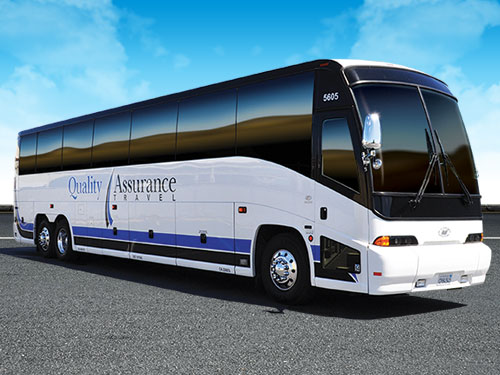
47 Passenger Bus
- Cushioned Seats
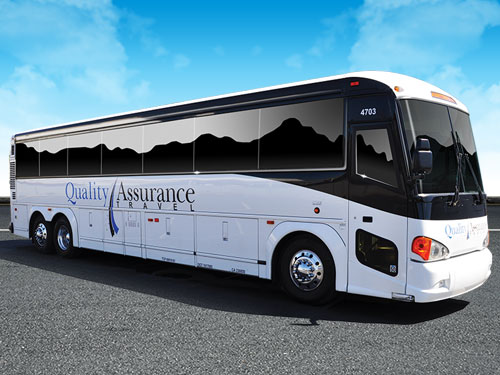
28 - 32 Passenger Bus
- LCD Monitors
- Leather Seats
- Rear Luggage
- Individual reading lights
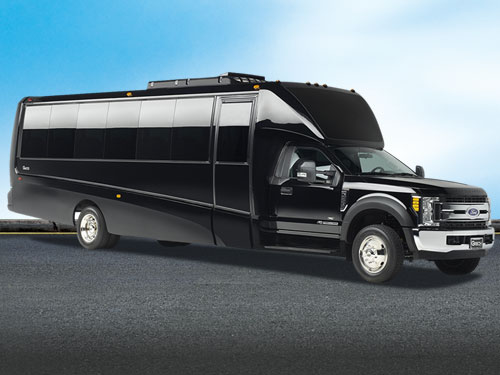
36 Passenger Bus
- 4 Video Monitors
- Read Storage
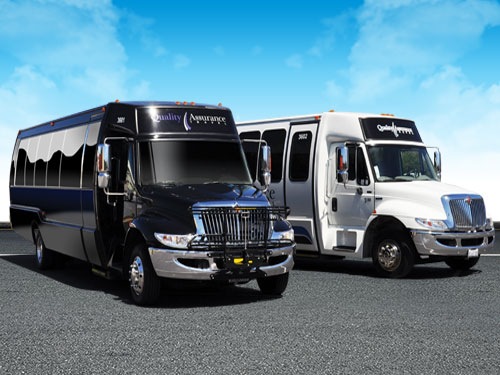
15 Passenger Bus
- Black-on-black
- Baggage Room
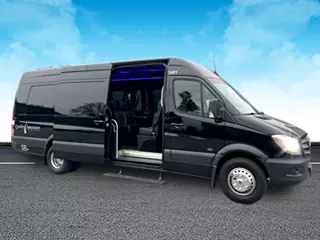
At QAT, we know how much is riding on your ride…
Wherever you and your friends, employees, guests or co-workers need to go in the Bay Area—a concert, baseball game, convention or casino, to the airport, a party or sports stadium—the bus charters of Quality Assurance Travel will get you there directly, safely and comfortably.
Experience the easiest, most reliable, most comfortable and safest way to charter a bus in the greater Bay Area… We are your total charter bus transportation solution, serving groups of all sizes and interests— in comfort and style!
Serving Groups of all type!

Employee shuttles
Enhace your employee experience with our efficient employee shuttle service!
Employee Shuttle Service, designed to revolutionize your daily commute. Say goodbye to the hassles of traffic, parking, and unreliable public transportation.

Wedding shuttles
Make your special Day even more memorable with our luxurious wedding bus
Our Wedding Bus Service offers the perfect blend of elegance, convenience, and fun to make your special day even more memorable.

Planning a corportae event? Elevate your guest's experience
Whether you’re a large corporation or a smaller business, we deliver professional, dependable and consistent service at rates that are hard to beat.

Sports Team
We handle the road ahead while you take your team to victory!
Bus charters for collegiate and major league sports teams—When everything’s riding on your game, shouldn’t you be riding with the best?
Tracking your bus with our app couldn't be easier.
With just a few taps, customers can access real-time updates on their bus's location, ensuring they never miss a beat. Our intuitive interface allows for effortless navigation, putting all the essential information right at your fingertips. Say goodbye to uncertainty and hello to seamless commutes with our user-friendly GPS app.
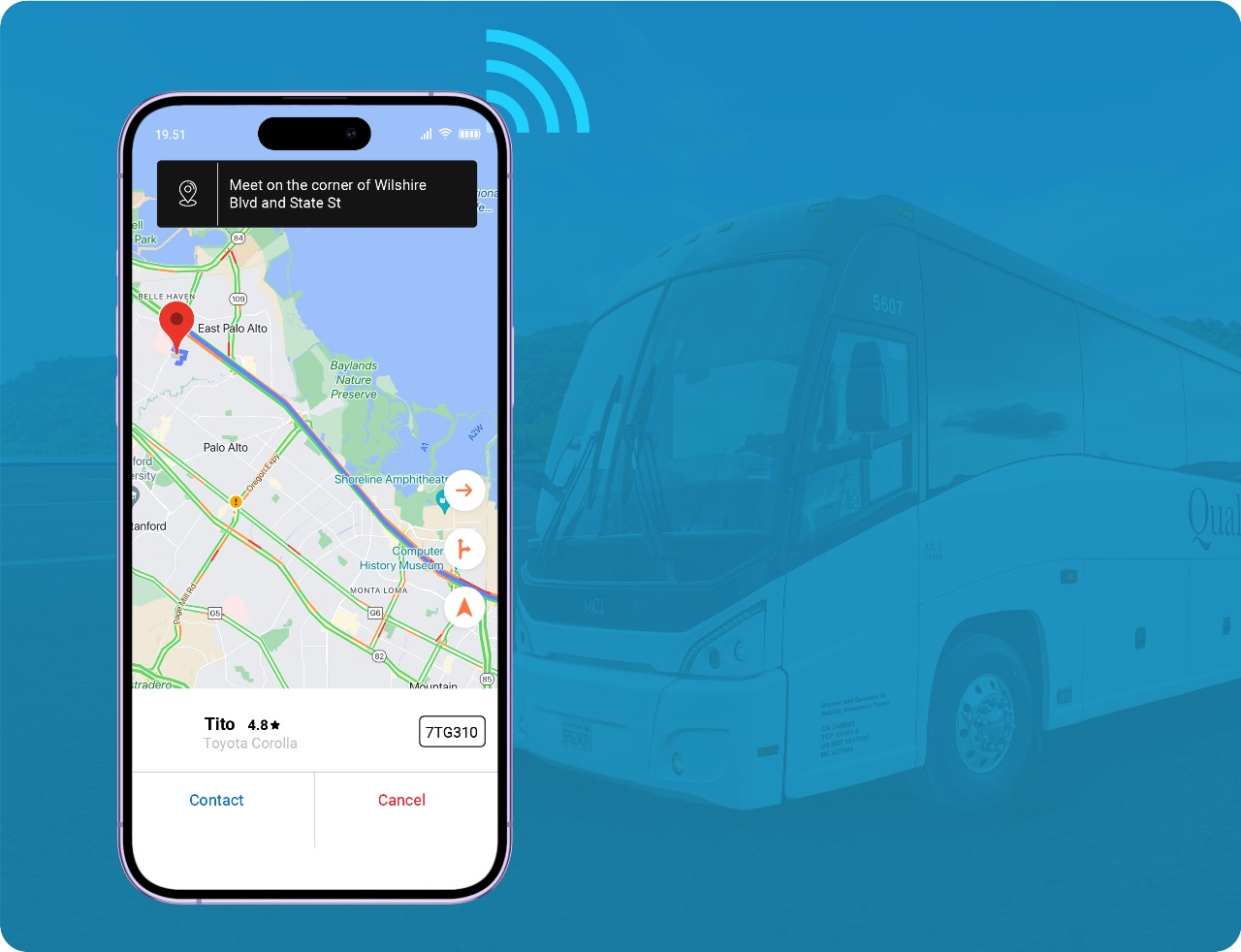
Discover the Difference!
Three reasons to choose quality assurance travel, family-owned and operated..
Our owners run the business as if it were their own, because it is their own! That’s why every detail is handled with care and an eye toward giving you the most enjoyable bus travel experience possible.
Bus Owners,NOT Bus Brokers.
There are lots of bus brokers out there who do not own their buses and/or will subcontract your charter reservation. So you not only end up with a bus company that you may never have heard of, but you could be paying a huge mark-up on the cost of your bus trip.
Beat any reasonable quote.
Along with the service and the bus coaches themselves, we guarantee you and your group will pay the lowest bus charter rate around. Have you received a quote from a Bay Area bus charter company that seems low or even too good to be true? Send it to us and we will beat it. Guaranteed.
What are Customers are saying about us
Quality Assurance Travel is absolutely the BEST! On December 27, all of our Southwest tickets were canceled and I had to find a way to get my entire hockey team down to Riverside California from San Jose for two mandatory hockey games. So, I considered looking into a motorcoach. Our driver was so professional, so kind, and even watched both of our hockey games. The bus was as clean and as comfortable as I could've prayed for!! I would recommend this company to anyone looking to rent a motorcoach, or a bus for any reason whatsoever.

Quality Assurance Travel is always my go-to bus travel company in the San Jose area. They do an amazing job communicating and taking care of your large group travel needs. I work for a school and I know I can rely on them to safely take our students to and from field trips. Huge shout out to Elena & Javier Moreno! Elena is so helpful in booking and Javier is a very experienced driver who is also very accommodating! Thank you again to this team, I appreciate everything!
Used Quality assurance travel shuttle this past Friday for my daughter's wedding. Bus driver was very friendly. Shuttle was clean and the drive was very smooth. Pick from the fairmont hotel was on time and pick up from city hall was also on time to drive to the restaurant. The pick up from the restaurant back to the hotel was also on time. I highly recommend this company for any events. No worry about driving around SF and parking
Trusted by leading public and private organizations

Contact Quality Assurance Travel
1585 Laurelwood Road, Santa Clara, CA 95054
Mailing Address: P.O. Box 59158, San Jose, CA 95954
Connect with us
Sign up to receive our monthly newsletter with special bus charter discounts!
Call 408.885.1040.
- Request a Quote
- Make a Payment
- Terms & Conditions
- Privacy Policy
Our Coaches

IMAGES
VIDEO
COMMENTS
Interstellar, in one of its most intense scenes, got it right. From our perspective in 3-D space, a wormhole should look like a sphere. Wormholes are an attractive approach to FTL technology ...
1. Hyperdrive. Popularized by Star Wars and used extensively in fiction, a hyperdrive enables a spaceship to travel at FTL speeds by entering another dimension known as "hyperspace.". The ...
First "realistic" solution for FTL travel, no unobtanium requirements. But those 30 orders of magnitude energy savings are equivalent to reduce the energy consumption from around 2500 Suns (3.8 ...
Since FTL travel is (as far as we know) impossible, portraying it in a realistic manner is not possible. However, you can maintain suspension of disbelief in your story by portraying it in a plausible and coherent manner within the confines of your universe. There are a few methods of FTL that have proven successful in sci-fi:
Not exactly a drive, but a system of wormholes or star-gates is the least unrealistic in my opinion. If the gates are located within systems reachable by STL they can be defined in frames that don't break causality, at least for the purpose of science fiction. I don't think there will ever be FTL travel in real life. 2.
The fastest ever spacecraft, the now- in-space Parker Solar Probe will reach a top speed of 450,000 mph. It would take just 20 seconds to go from Los Angeles to New York City at that speed, but it ...
Even worse, it's always possible to travel into your own past by doing the following: make an FTL jump. accelerate to a different velocity (I mean an ordinary, slower-than-light velocity) make an FTL jump in the opposite direction. and provided you chose your velocity correctly in step 2, you can arrive in your own past.
The Honorverse includes several different forms of FTL travel, and I must admit I'm confused about the differences. There's 'hyper', which has different 'bands', each with a different relative speed compared to n-space. This is the most common form of travel I've seen referenced.
Within a couple of decades, the fictional idea of faster-than-light travel made intuitive sense to a public familiar with recent supersonic flights. In 1947, Chuck Yeager broke the speed of sound aboard the Bell X-1 Glamorous Glennis. Writers extrapolated supersonic speeds into the idea of spacecraft traveling at multiples of the speed of light.
Fictional representations of faster-than-light (FTL) travel have been a mainstay in science fiction literature and media. In order to be considered credible by audiences, these representations are ...
In layman's terms, the Alcubierre Drive achieves FTL travel by stretching the fabric of space-time in a wave, causing the space ahead of it to contract while the space behind it expands. In theory, a spacecraft inside this wave would be able to ride this "warp bubble" and achieve velocities beyond the speed of light.
Jumps - Guardians Of The Galaxy. The Marvel Cinematic Universe has its own method of FTL travel, but we wouldn't have included it if it hadn't been for the insane scene in Guardians of the Galaxy Vol. 2. Yondu, Rocket, Kraglin, and Groot make 700 "jumps" through space-time in order to reach the rest of the team on Ego's planet in time.
Other than it being a common trope there is little reason for most science fiction to actually have faster than light travel. There is plenty of room in the solar system for huge empires, deviant human strains (which eliminates the need for horribly unrealistic human-like aliens, since they can just be humans!), massive objects and huge spaceships. 99% of all science fiction, including space ...
Their calculations further indicated that this could be done with a negative vacuum energy density roughly equivalent to the size of Jupiter (1.898×1024 kg; 4.18×1024 lbs).
Faster-than-light travel is a fairly workmanlike trope in sci-fi. Few stories are based entirely around it, it's usually just the answer to the simple question of time-consuming space travel ...
The "Relativity and FTL Travel" FAQ was created mainly for the rec.arts.startrek.tech newsgroup. Much of it contains solid information about relativity (written mainly for the lay-person), while one important part discusses why relativity tends to forbid faster than light travel. It explains why no fictional and/or theoretical idea for FTL ...
a realistic sci-fi world with limited FTL travel Pick one. You can make FTL travel consistent and logical, but not realistic. FTL drives would have a maximum jump range of 0.5-5 light years (depending on the range of human space civilisation) Is that 5ly from a fixpoint or 5ly per jump - and what stops a ship from chaining jumps?
At QAT, we know how much is riding on your ride… Wherever you and your friends, employees, guests or co-workers need to go in the Bay Area—a concert, baseball game, convention or casino, to the airport, a party or sports stadium—the bus charters of Quality Assurance Travel will get you there directly, safely and comfortably.
JJ Travel Agency. 10787 S Blaney Ave Cupertino CA 95014 (408) 446-5588. Claim this business (408) 446-5588. Website. More. Directions Advertisement. Hours. Website Take me there. Find Related Places. Travel Agents. See a problem? Let us know. Advertisement ...
Zillow has 26 photos of this $770,000 1 bed, 1 bath, 747 Square Feet condo home located at 1850 El Camino Real UNIT 306, Santa Clara, CA 95050 built in 2022. MLS #ML81961243.
OCSSD with SPDK FTL. •SPDK FTL on Marvell's OSSD Platform. • We have been evaluating SPDK FTL on Marvell's SSD So platform since Jan '19. •SPDK (Flash Translation Layer) FTL: The Flash Translation Layer library provides block device access on top of non-block SSDs implementing Open Channel interface.
These two. None of them are scientifically applicable, but they are as close to the "realistic" as you can get without going STL. No FTL method is possible in out universe, because no matter can travel faster than light. Check out wormholes from the Orion's Arm Universe Project. They deal in hard sci-fi and concepts strictly based on possible ...